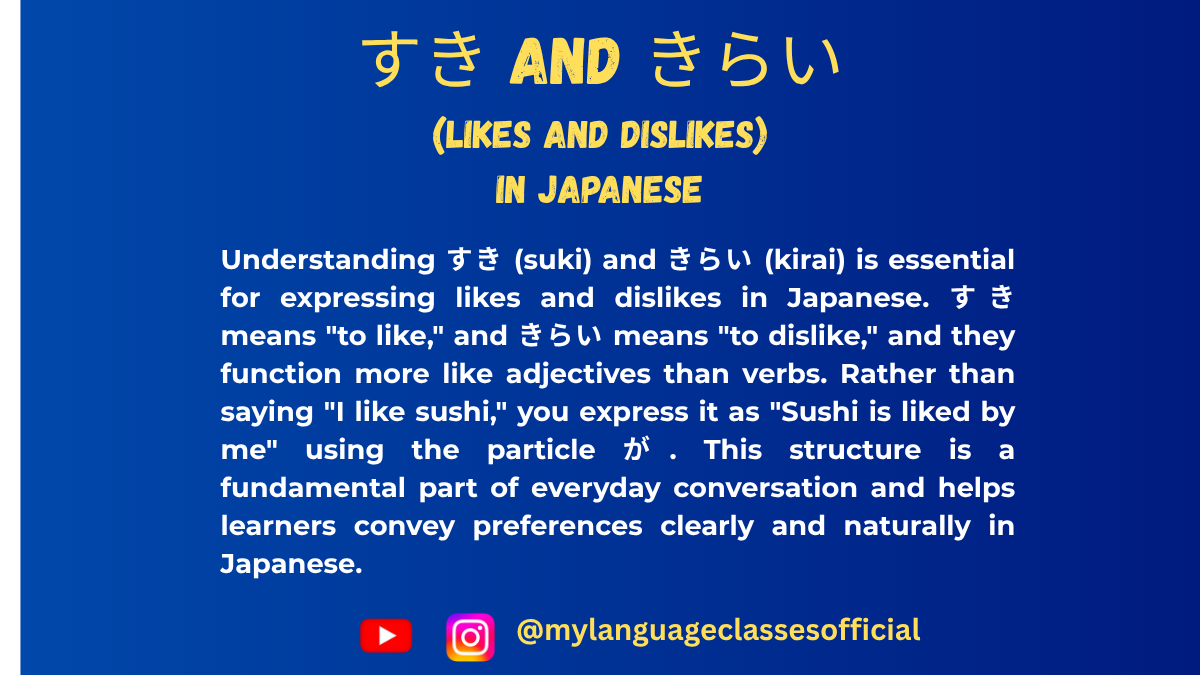Your cart is currently empty!
Expressing Likes and Dislikes すき and きらい in Japanese

Likes and Dislikes in Japanese
こんにちは!(Konnichiwa!)
Learning how to express preferences is one of the most useful and fun parts of mastering Japanese. Today, let’s dive into two essential words: 好き (すき) for “like” and 嫌い (きらい) for “dislike.” Not only will we explore their meanings, but also how to use them naturally in sentences.
1. 好き (すき) – To Like
How to Use 好き
The word 好き means “like” or “fond of” and is commonly used to express your preferences. The structure is simple:
Noun + が好き
This translates to “I like [noun].”
Examples:
- 日本語が好きです。
Nihongo ga suki desu.
I like Japanese.- Here, 日本語 (Nihongo) means “Japanese,” and が marks it as the topic you like. Adding です makes it polite.
- 犬が好き。
Inu ga suki.
I like dogs.- This informal version is common among friends or in casual settings.
Expressing Love or Passionate Likes
To emphasize your love or deep passion for something, you can use 大好き (だいすき/daisuki):
- チョコレートが大好きです!
Chokorēto ga daisuki desu!
I love chocolate!
2. 嫌い (きらい) – To Dislike
How to Use 嫌い
On the flip side, 嫌い means “dislike” or “hate.” The structure is the same as 好き:
Noun + が嫌い
This means “I dislike [noun].”
Examples:
- ピザが嫌いです。
Piza ga kirai desu.
I dislike pizza.- ピザ (Piza) means “pizza.” While it’s a popular dish, some people might find it too greasy!
- 虫が嫌い。
Mushi ga kirai.
I hate insects.- 虫 (Mushi) refers to “insects.” Use this informal structure with friends.
Expressing Strong Dislike
If you strongly dislike something, you can say 大嫌い (だいきらい/daikirai):
- 雨が大嫌いです!
Ame ga daikirai desu!
I hate rain!
3. Cultural Notes
- “Softer Tone for Dislikes”: In Japanese culture, direct expressions of dislike like 嫌い might come off as too strong in some situations. To soften it, you can use phrases like:
- あまり好きじゃない (Amari suki janai) – “I don’t really like [it].”
- ちょっと苦手です (Chotto nigate desu) – “I’m a bit bad with [it].”
- Overuse of 好き: While 好き is positive, saying it too often might sound insincere. Balance your expressions to match the context.
4. Grammar and Nuance Tips
- No Verb Needed:
Both 好き and 嫌い function as な-adjectives, not verbs. This means they don’t need any conjugation or additional verbs to form basic sentences.Example:- Correct: 猫が好きです。 (Neko ga suki desu. – “I like cats.”)
- Incorrect: 猫が好きをです。 (Neko ga suki wo desu. – This is ungrammatical.)
- が (Ga) vs. は (Wa):
Although が is standard for these structures, は can be used for contrast or emphasis:- 犬は好きですが、猫は嫌いです。
Inu wa suki desu ga, neko wa kirai desu.
I like dogs, but I dislike cats.
- 犬は好きですが、猫は嫌いです。
5. Practice Time!
Let’s put what you’ve learned into action. Try completing these sentences:
- 私は ______ が好きです。
(Watashi wa ______ ga suki desu.)- Translate: “I like ______.”
- 友達は ______ が嫌いです。
(Tomodachi wa ______ ga kirai desu.)- Translate: “My friend dislikes ______.”
- ______ は大好きです!
(______ wa daisuki desu!)- Translate: “I love ______!”
6. Wrap-Up
Now you can confidently express what you like and dislike in Japanese! Start practicing by talking about your favorite foods, hobbies, and activities. Try to notice how native speakers use 好き and 嫌い in conversations—it will deepen your understanding.
If you have questions or want to share your sentences, feel free to leave a comment below!
それでは、またね!(Soredewa, matane!)
If you enjoyed this lesson, be sure to check out more posts like this on my blog at My Language Classes. Don’t forget to subscribe my YouTube channel and follow me on Instagram for the latest language learning tips and lessons. Leave a comment below to share your thoughts, or ask any questions you have about nouns.
Happy learning! 😊
📚 Continue Learning Japanese
Vikas Kumar is a dedicated language educator, content creator, and digital entrepreneur, best known as the co-founder of My Language Classes and The Curious Mind. With a strong focus on helping learners achieve fluency in English, Spanish, and Japanese, he has guided audiences worldwide through a diverse range of resources, including in-depth blog articles, engaging YouTube tutorials, and comprehensive Books.
Through My Language Classes, Vikas has built a thriving multilingual learning platform that serves students, travelers, and professionals eager to master communication skills for personal, academic, and professional success. His expertise extends to exam preparation for internationally recognized certifications such as JLPT, DELE, IELTS, and TOEFL, enabling learners to achieve tangible, career-enhancing results.
As the founder of The Curious Mind, he also explores broader areas of knowledge, including self-help, motivation, modern learning strategies, and thought-provoking insights on life and personal growth. His work blends practical teaching methods with a deep understanding of learner psychology, making complex concepts accessible and engaging.
Driven by a mission to make high-quality education accessible to all, Vikas continues to expand his reach across multiple platforms, including YouTube, blogs, eBooks, and social media communities, inspiring thousands to learn, grow, and embrace lifelong learning.


Leave a Reply